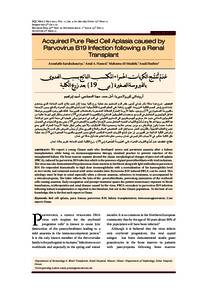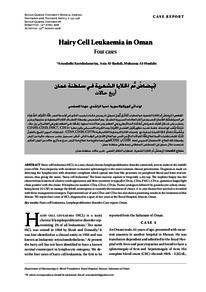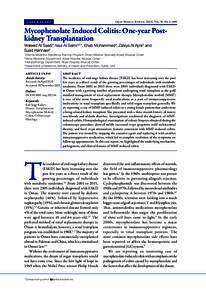Document
Acquired pure red cell aplasia caused by parvovirus B19 infection following a renal transplant.
Contributors
Other titles
عدم تنسج الكريات الحمراء المكتسب الناتج بسبب العدوى بالفيروسة الصغيرة (بي ١٩) بعد زرع الكلية.
Publisher
College of Medicine, Sultan Qaboos University.
Gregorian
2011-05
Language
English
Subject
English abstract
We report a young Omani male who developed severe and persistent anaemia after a kidney transplantation while being on immunosuppression therapy, standard practice to prevent rejection of the transplanted kidney. His bone marrow aspirate showed the classic morphological changes of pure red cell aplasia (PRCA), induced by parvovirus B19 infection which is the presence of giant proerythroblasts with viral inclusions. The virus was also demonstrated by polymerase chain reaction in the blood along with IgM antibodies to parvovirus B19. He responded dramatically to high dose immunoglobulin with a normalisation of his haemoglobin level in two weeks and remained normal until seven months later. Parvovirus B19 induced PRCA can be cured. This aetiology must be kept in mind especially when a chronic anaemia, refractory to treatment, is accompanied by a reticulocytopenia. The latter reflects the lysis of the proerythroblasts, preventing maturation of the erythroid cells causing anaemia. Early recognition and prompt treatment spares the patient unnecessary exposure to blood transfusions, erythropoietin and renal disease caused by the virus. PRCA secondary to parvovirus B19 infection following kidney transplantation is reported in the literature, but not in the Omani population. To the best of our knowledge, this is the first such report in Oman.
Member of
Resource URL
Citation
Kurukulasuriya, Arundathi، Hamed, Amal A، Al-Muslahi, Muhanna، & Ibrahim, Asaid (2011). Acquired Pure Red Cell Aplasia caused by Parvovirus B19 Infection following a Renal Transplant. SQU MED J, 11(2),280-283.
Arabic abstract
ندرج هنا حالة ذكر عماني أصيب بفقر الدم المستديم بعد عملية زرع كلية بينما كان تحت علاج كابت المناعة، الذي يستخدم عادة لمنع رفض الجسم للكلية المزروعة. أظهرت رشافة نقي العظم الصورة الكلاسيكية لعدم تنسج الكريات الحمراء والناتج بسبب الإصابة بالفيروسة الصغيرة (بي 19) وبوجود ليفة الأرومة الحمراء العملاقة المصحوبة بالمشتملات الفيروسية. كذلك ظهر وجود الفيروس بواسطة تفاعل البوليميريز المتسلسل في الدم مع مستضدات الغلوبولين المناعي (ام) للفيروسة الصغيرة (بي 19). استجاب بشكل كبير لجرعة عالية من الغلوبولين المناعي حيث عاد مستوى الهيموجلوبين الى المستوى الطبيعي في الدم في اسبوعين وبقي طبيعيا الى سبعة أشهر حين تم كتابة هذا التقرير، وبهذا تم علاج عدم تنسج الكريات الحمراء الحاصل بسبب الإصابة بالفيروسة الصغيرة (بي 19). يجب وضع السببيات في الحسبان خاصة عندما يكون هناك فقر دم مزمن يصعب علاجه ومصحوبا بقلة الشبكات، والأخير يعكس تحلل ليفة الأرومة الحمراء، الذي يمنع نضوج الخلايا الشبيهة بالكريات الحمر مسببا فقر الدم. التشخيص المبكر والعلاج الفوري يمكن أن يجنب المريض نقل الدم والإريثروبويتين وأمراض الكلية الناتجة عن الفيروس. إن عدم تنسج الكريات الحمراء المكتسب الناتج بسبب العدوى بالفيروسة الصغيرة (بي 19) بعد عملية نقل الكلية مذكور في الأدبيات، لكن ليس في عمان، وحسب معلوماتنا تعتبر هذه أول حالة في عمان.
Category
Journal articles



